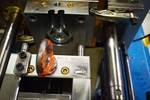INN-PAEK project succeeds in 100% recyclable turbine
European project replaces complex-shaped metal structure in aircraft cooling system with injection molded thermoplastic composite material for improved sustainability.
Share
Read Next
Carbon fiber-reinforced PAEK composite turbine wheel and flange demonstrated in INN-PAEK project. Photo Credit: INN-PAEK project, Aitiip Technology Center
Aitiip Technology Center (Zaragoza, Spain), in collaboration with the Liebherr Group (Bulle, Switzerland), has completed the three-year European INN-PAEK project and achieved promising scientific-technical results. CW reported on the project’s goals in January 2023. Aitiip has now succeeded in developing an innovative proprietary technology that enables the production of parts with complex geometries using thermoplastic composite materials and one-shot injection processes.
INN-PAEK has successfully demonstrated these materials and processes by manufacturing a turbine used in aircraft cooling systems. Aitiip reports that this is a revolutionary demonstrator — until now, only metallic materials had been used. In contrast, thermoplastic polymer composites reinforced with carbon fiber offer advantages such as lightweight, high mechanical properties, resistance to corrosion, moisture and chemicals, as well as improved versatility. They can also be recycled at the end of the part’s useful life and reused for the manufacture of new parts.
INN-PAEK’s technological solution makes it possible to replace the conventional manufacturing process of today’s metal turbines, where the various parts are welded together, with an injection molding process that favors “one-shot” production, thus optimizing cycle time, energy consumption and cost reduction. Aitiip has adapted this injection process to the particular and complex geometry required for the production of these aircraft cooling turbines, while using a lighter weight, more sustainable construction.
INN-PAEK was able to demonstrate materials and processes to enable a 40% weight reduction and 30% cost reduction, as well as improve sound absorption properties in the final part. The project’s results are offered as an advanced, more sustainable and environmentally friendly production system from which the aviation industry of the future can benefit. This industry is being redirected by Europe towards circularity that will require alternative structures and components in the coming years to achieve the goal of reducing fuel consumption and CO2 emissions by 20%. It is estimated that some 40,000 new aircraft will be needed over the next two decades to meet transport needs.
INN-PAEK's research has received almost €800,000 in funding from the Clean Sky 2 Joint Undertaking, now Clean Aviation, within the European Union’s Horizon 2020 framework program.
Related Content
-
Sulapac introduces Sulapac Flow 1.7 to replace PLA, ABS and PP in FDM, FGF
Available as filament and granules for extrusion, new wood composite matches properties yet is compostable, eliminates microplastics and reduces carbon footprint.
-
Plant tour: Albany Engineered Composites, Rochester, N.H., U.S.
Efficient, high-quality, well-controlled composites manufacturing at volume is the mantra for this 3D weaving specialist.
-
The lessons behind OceanGate
Carbon fiber composites faced much criticism in the wake of the OceanGate submersible accident. CW’s publisher Jeff Sloan explains that it’s not that simple.

















